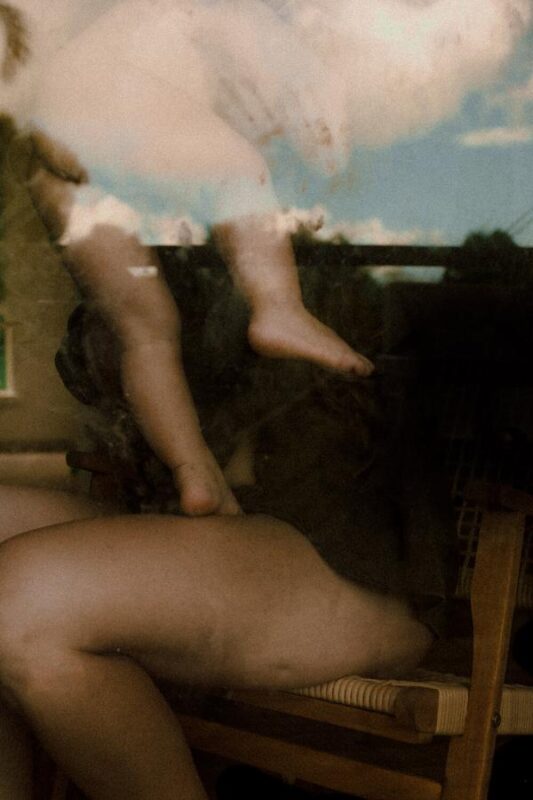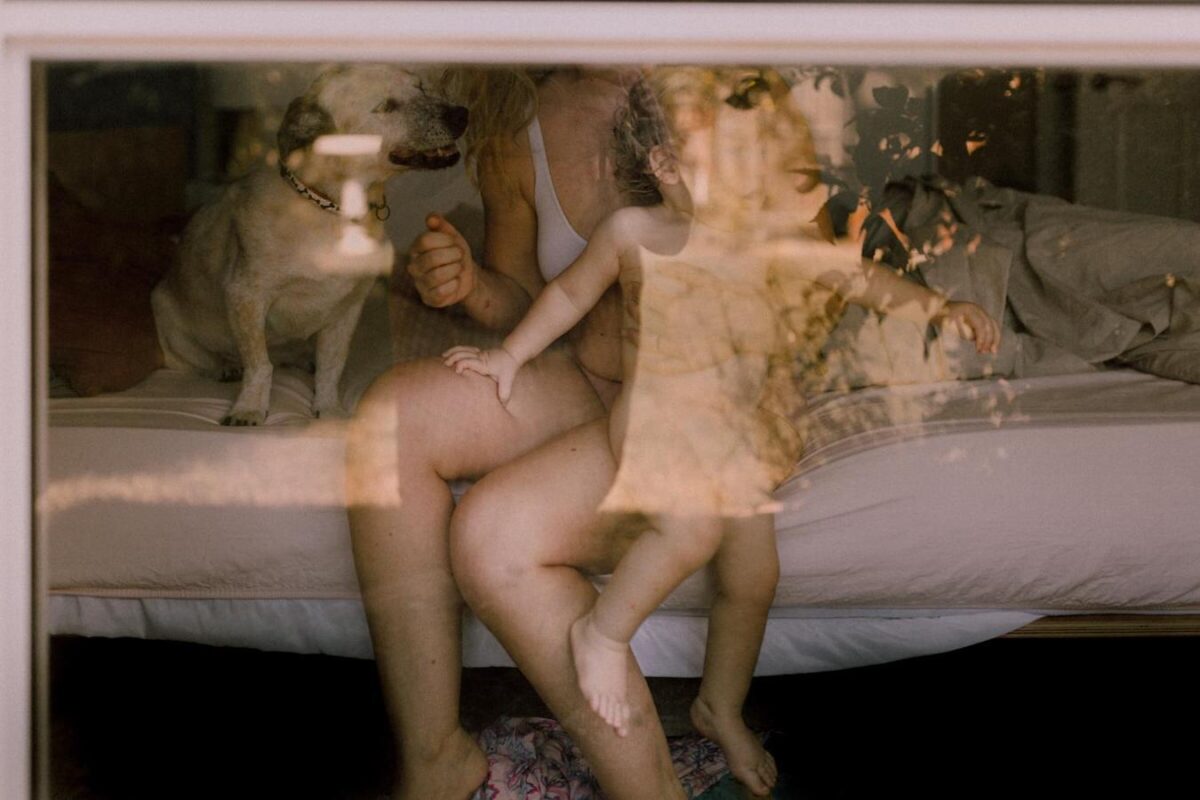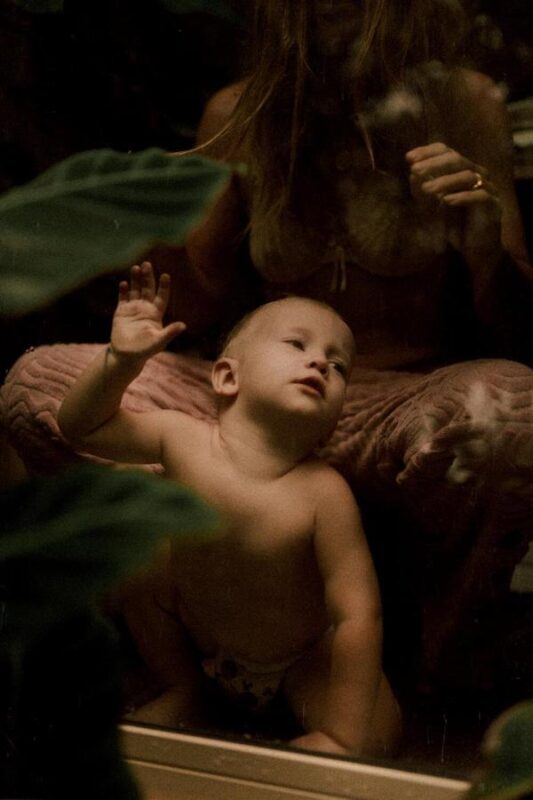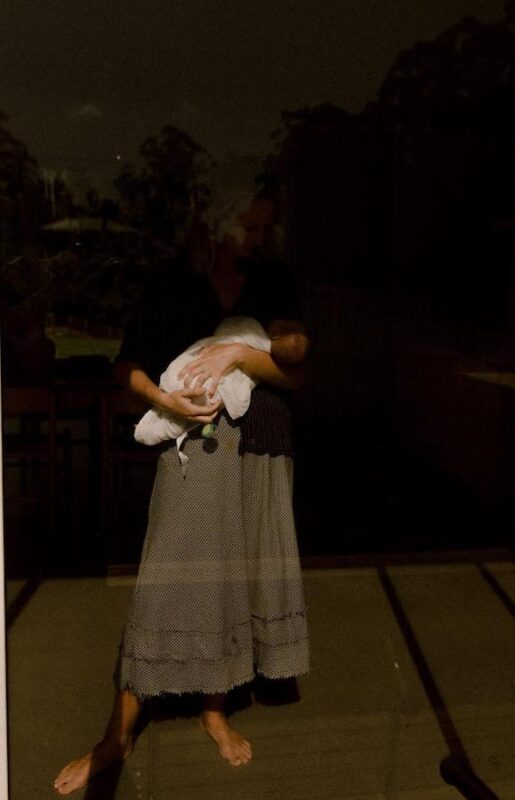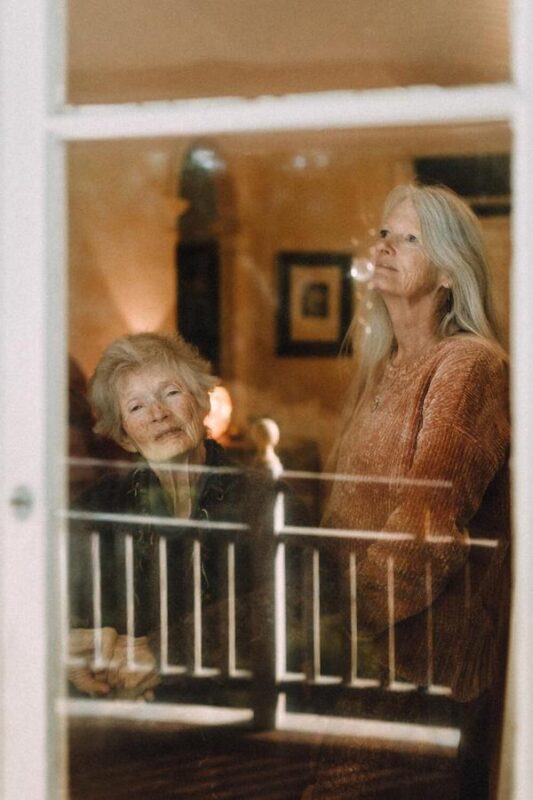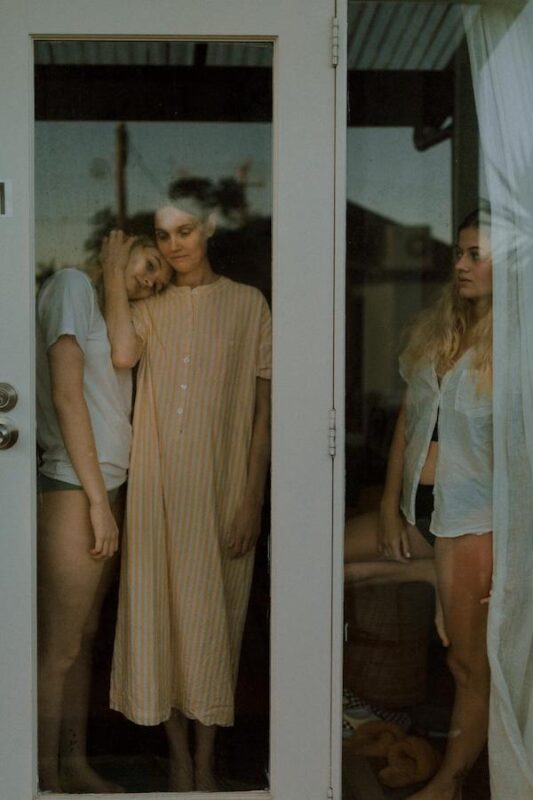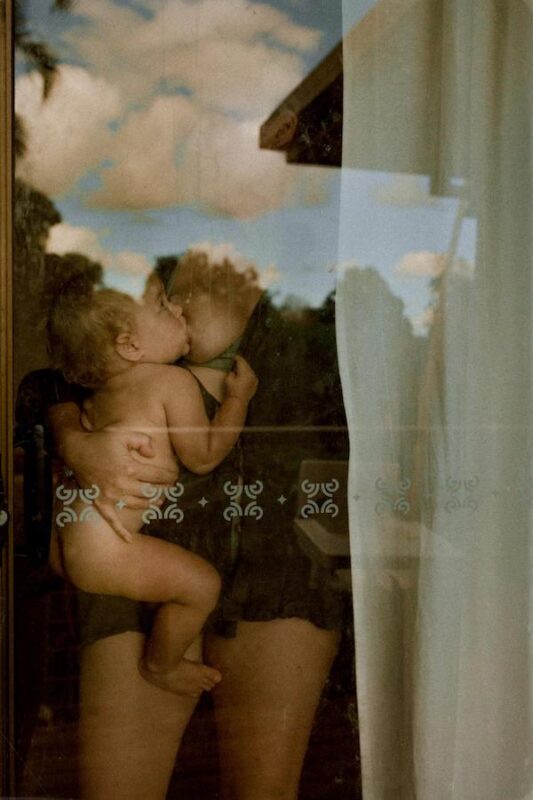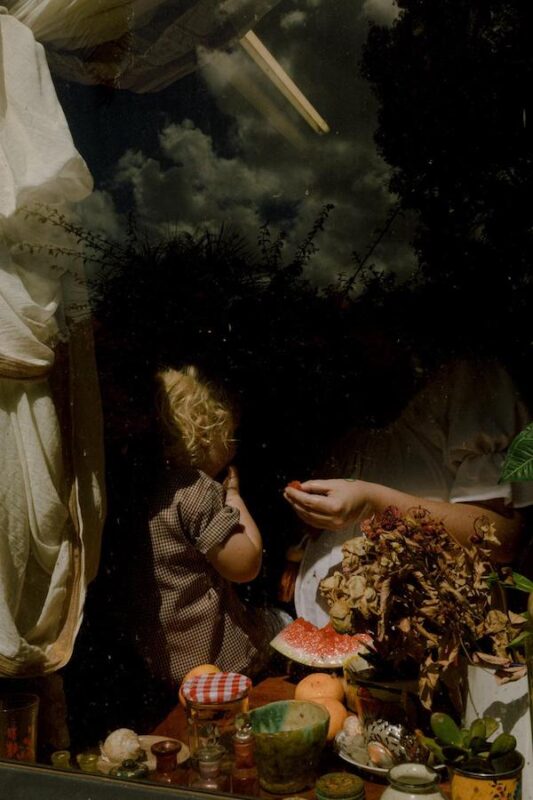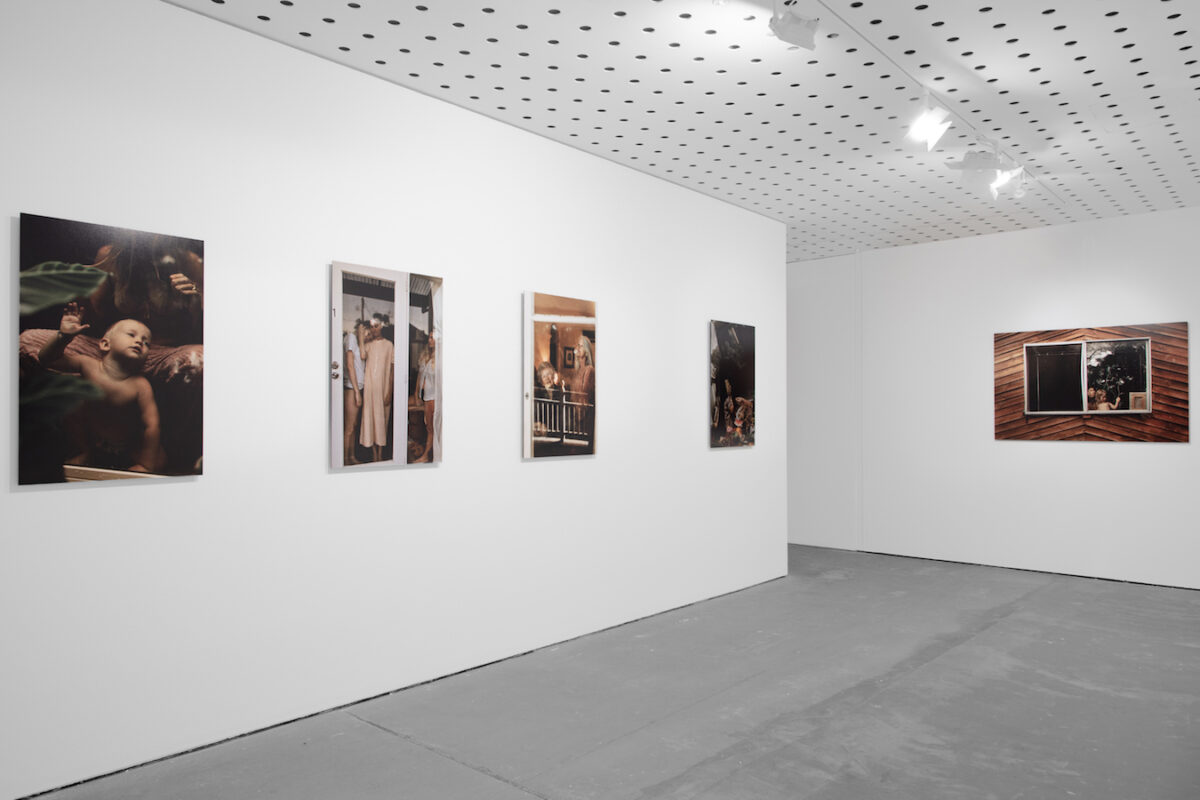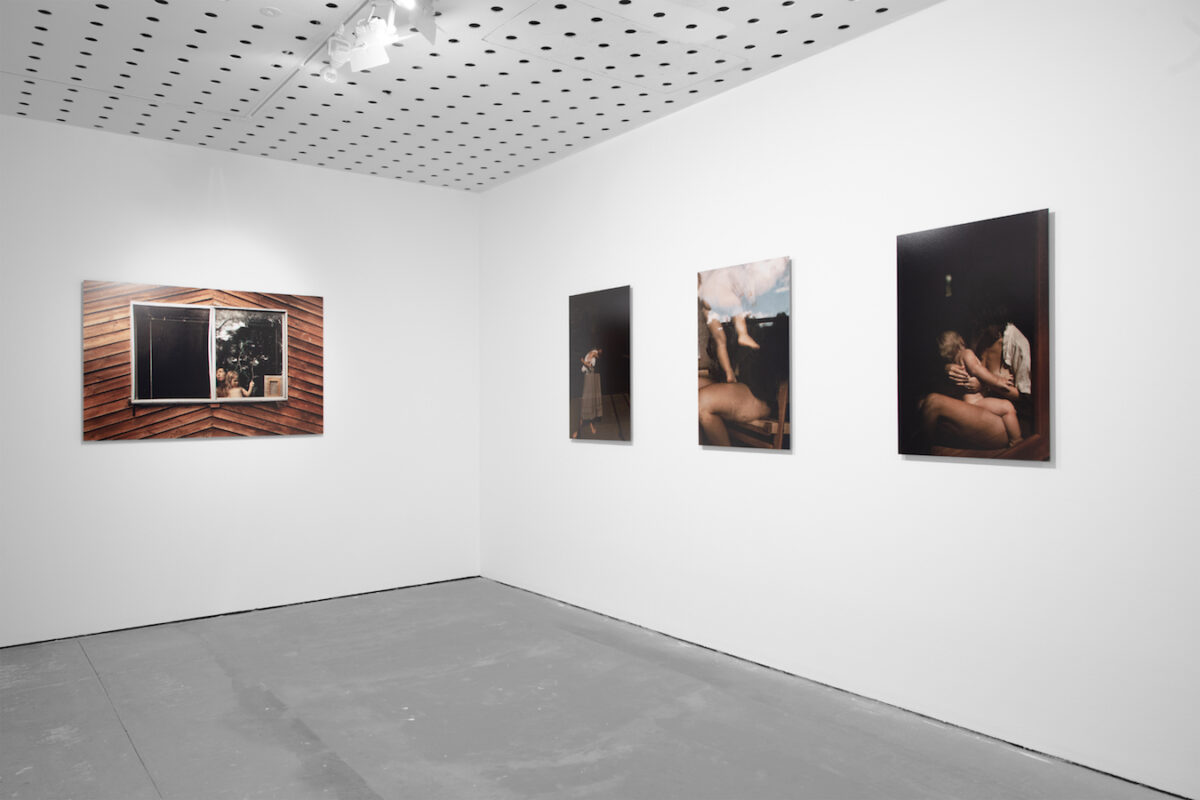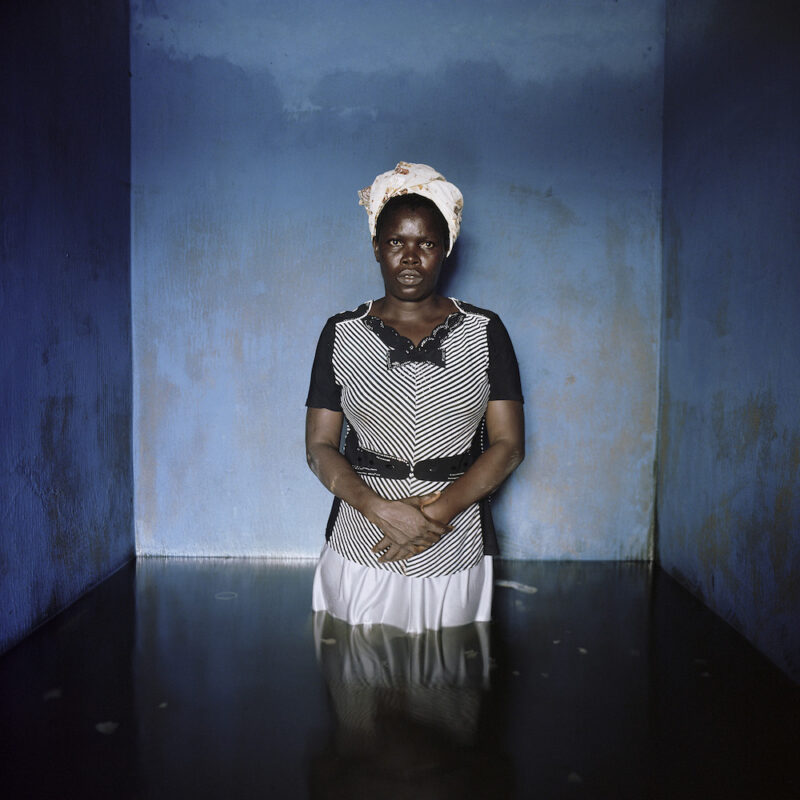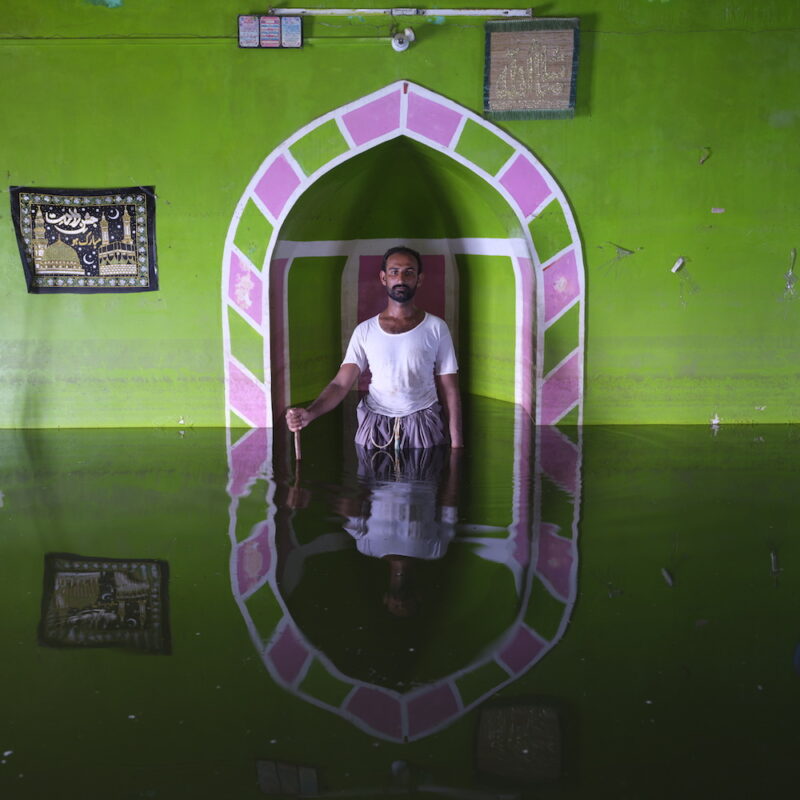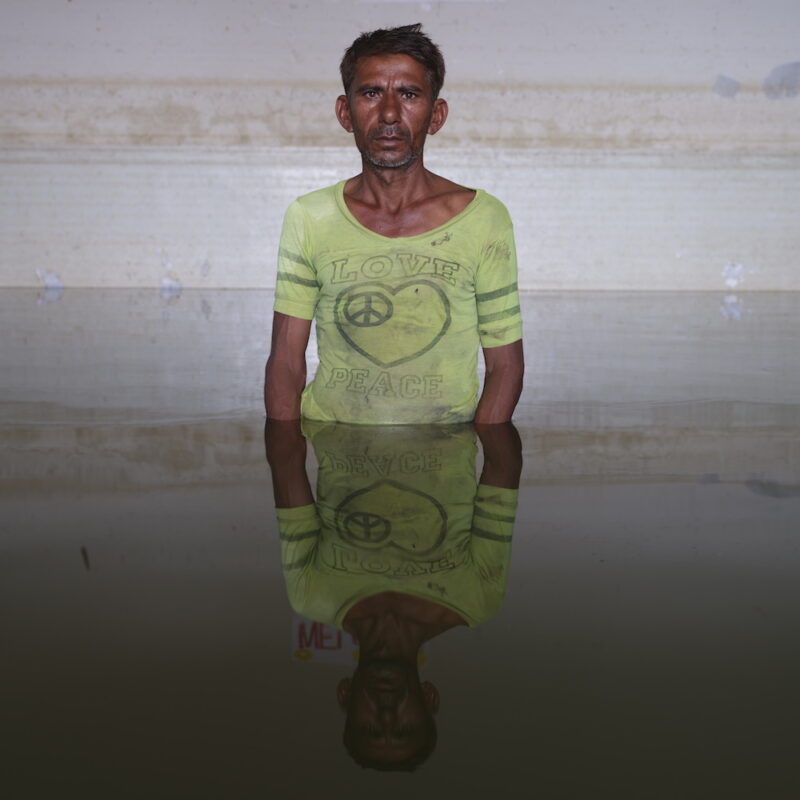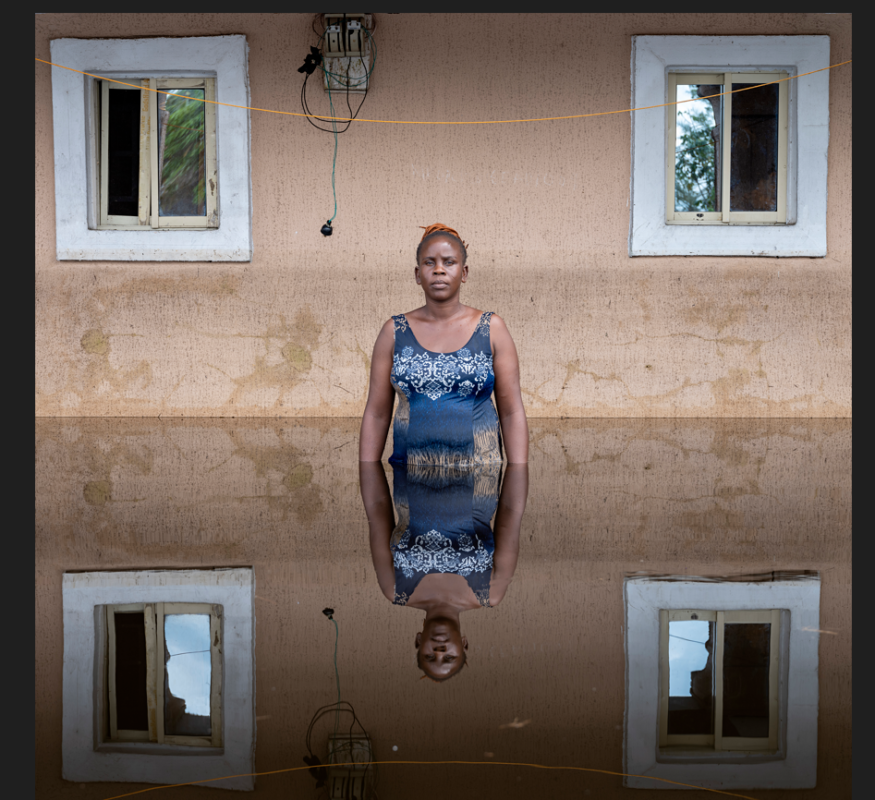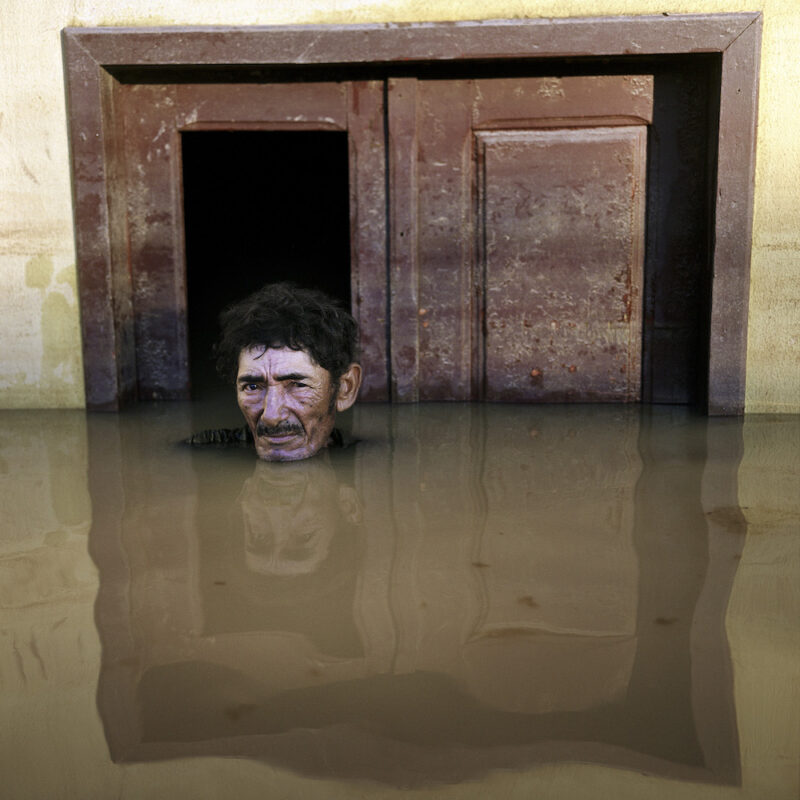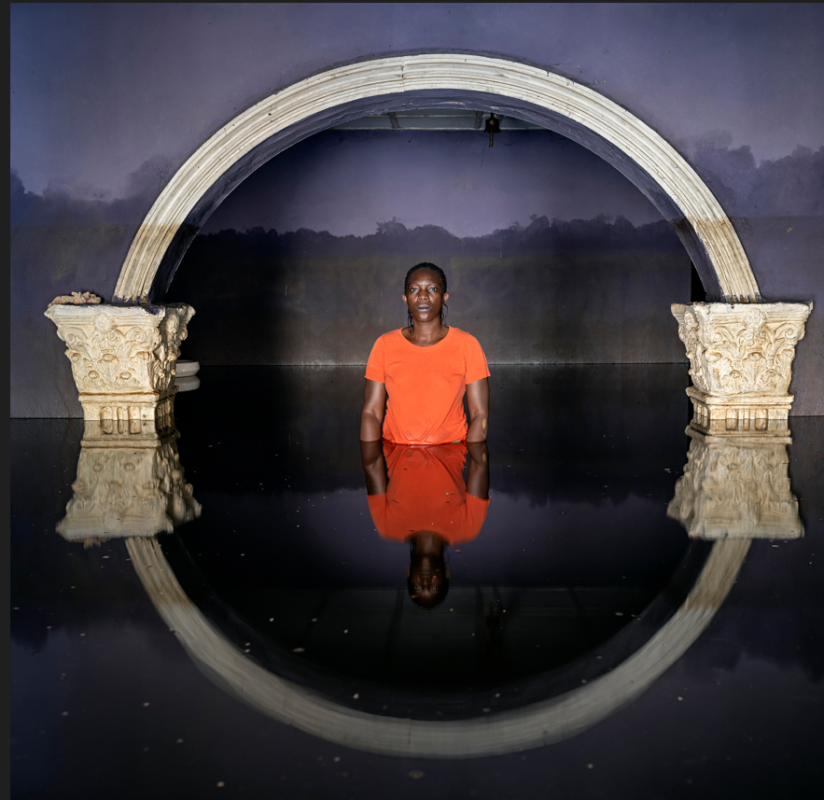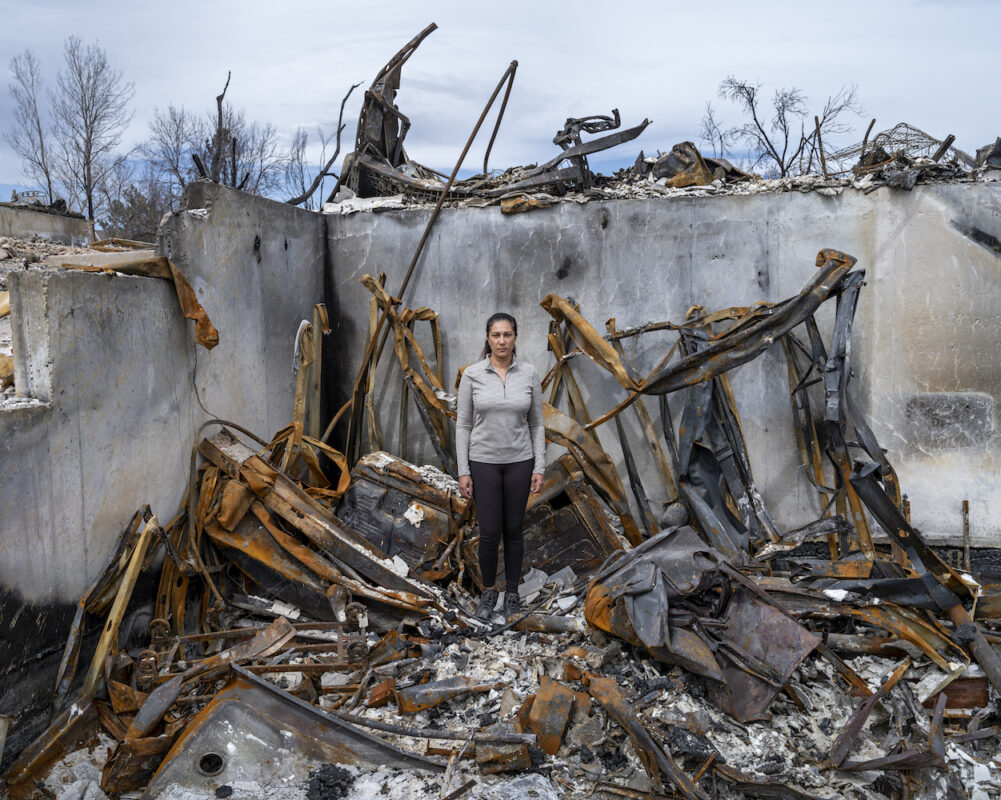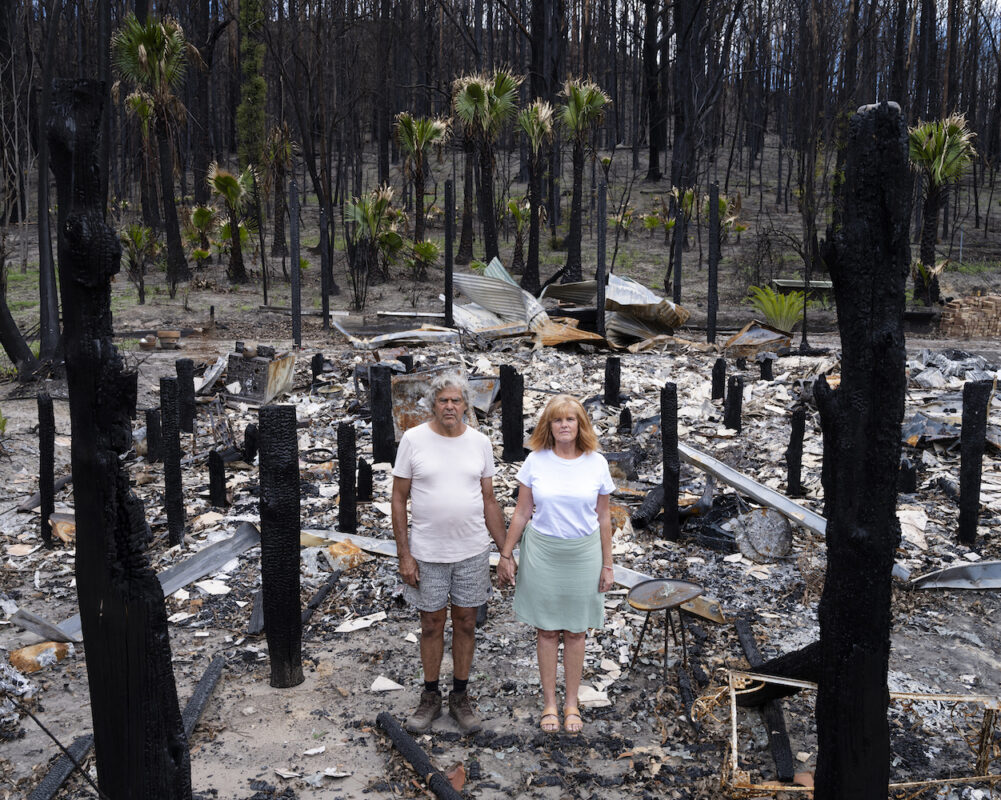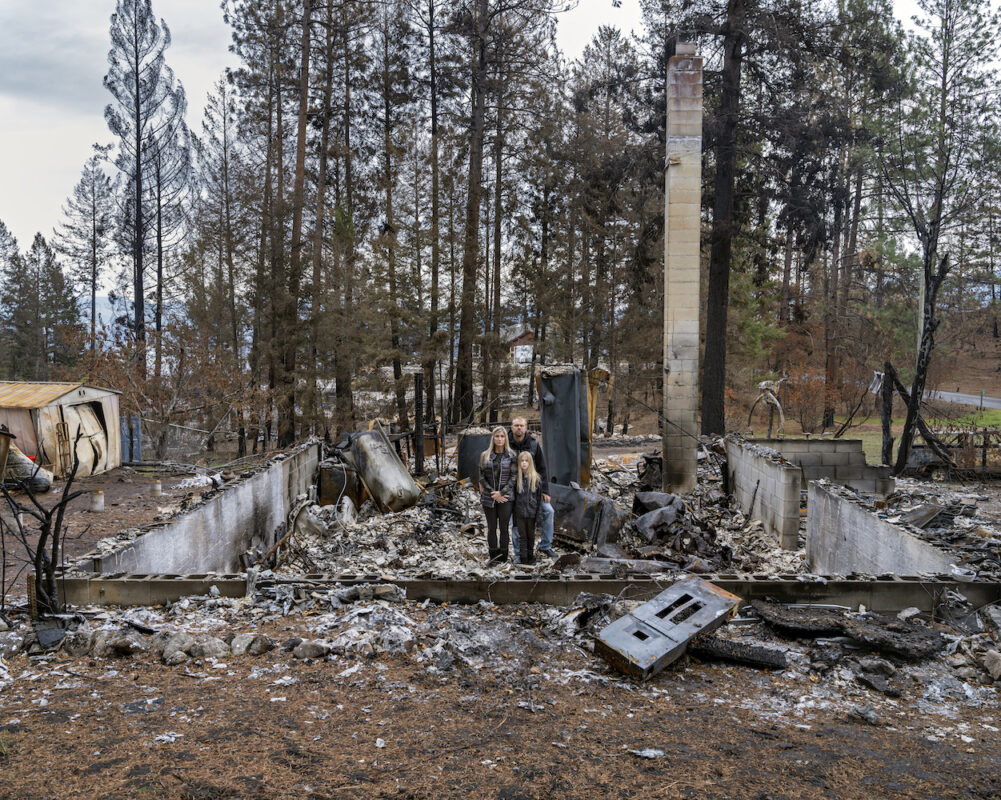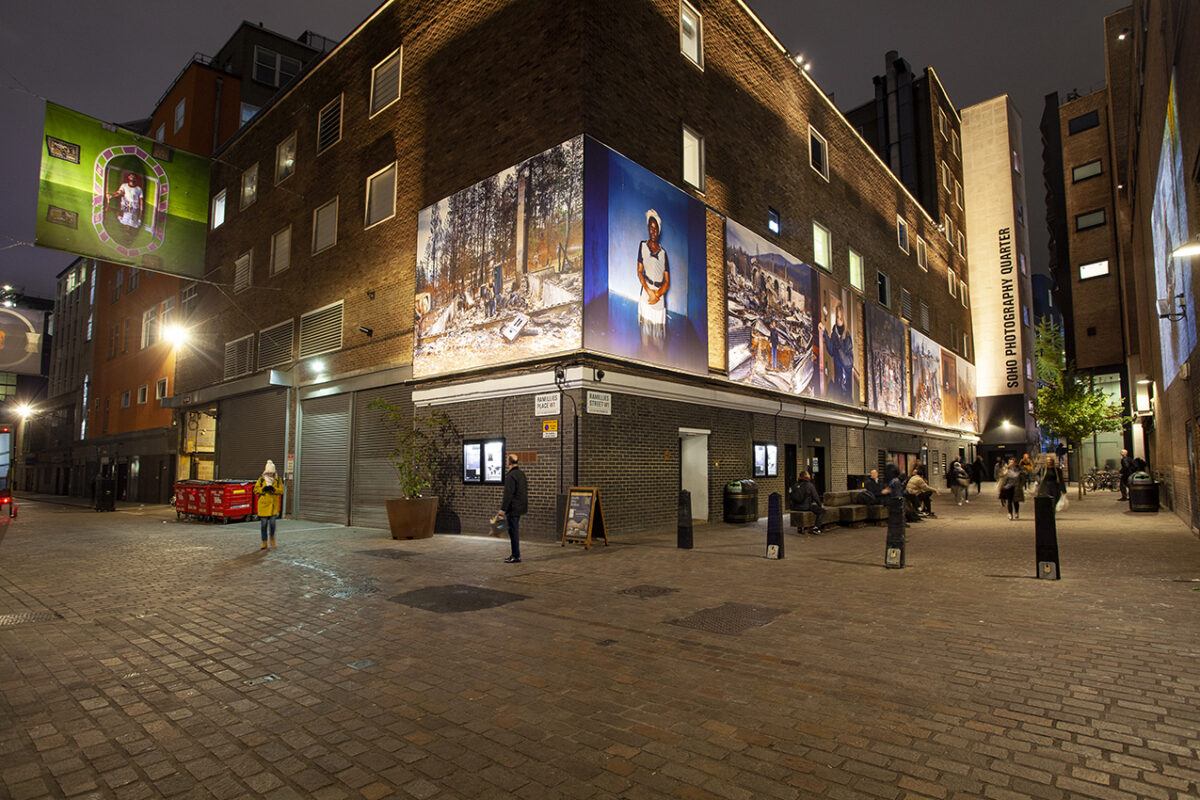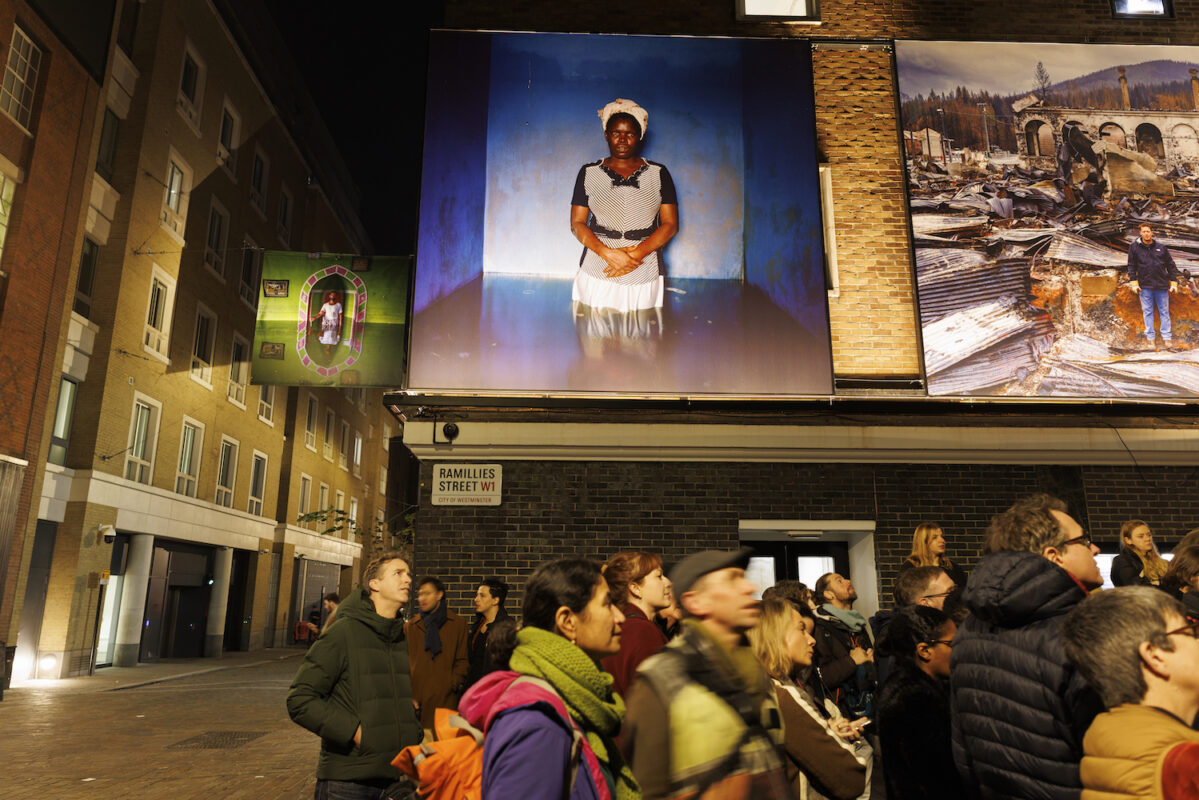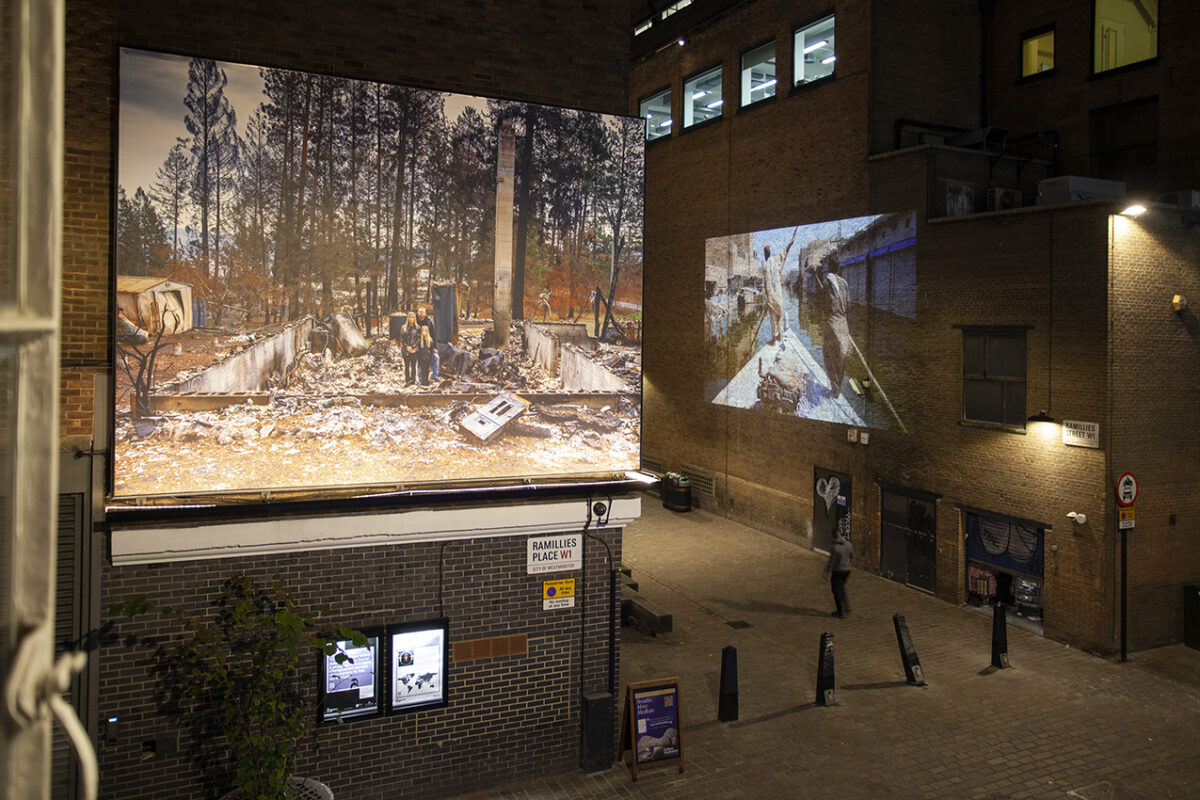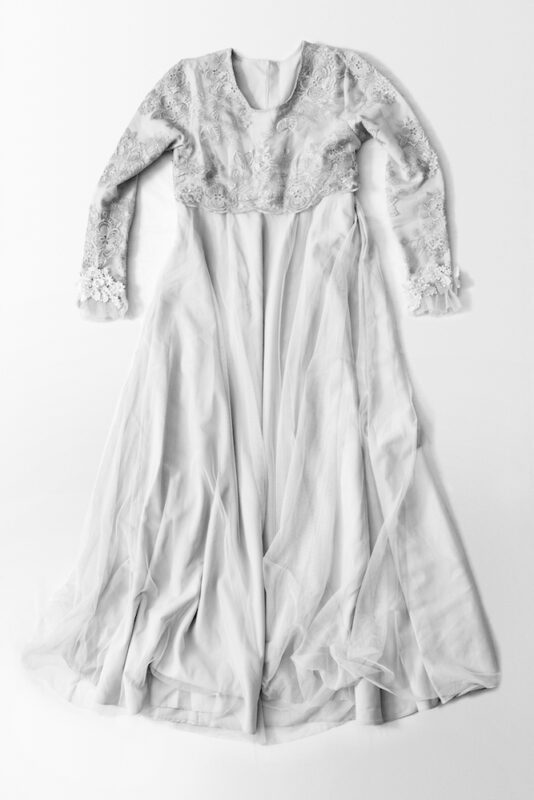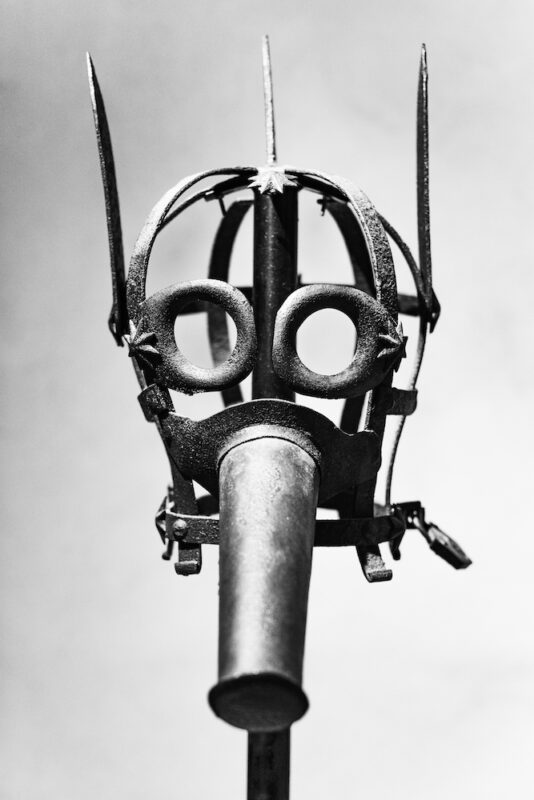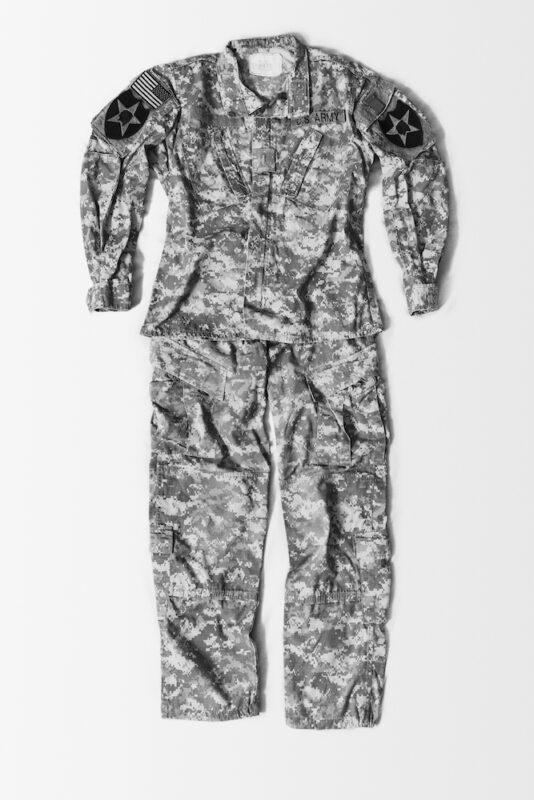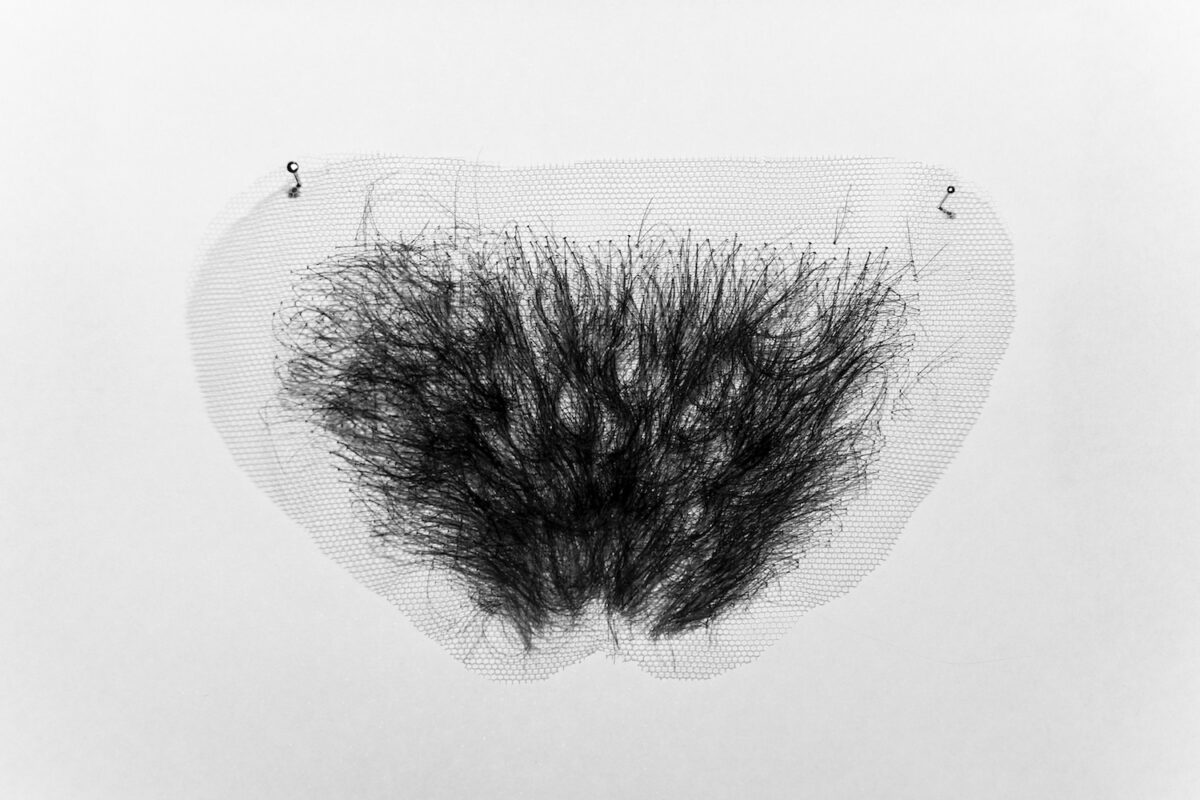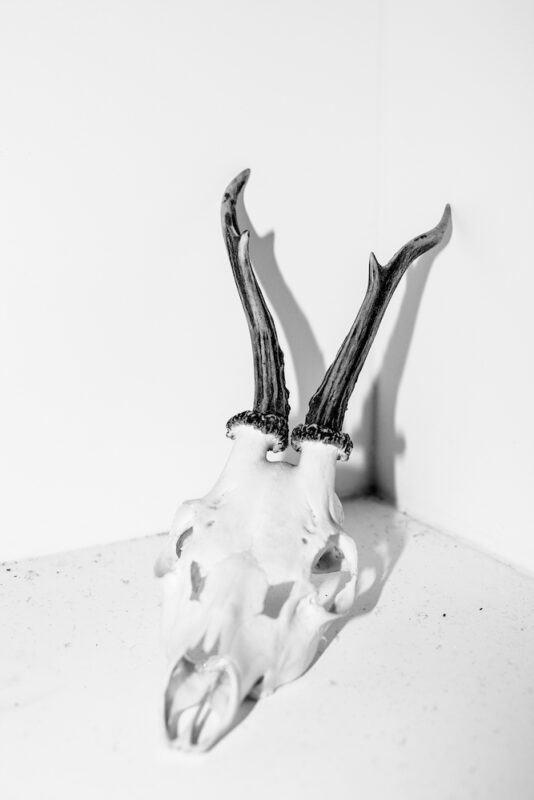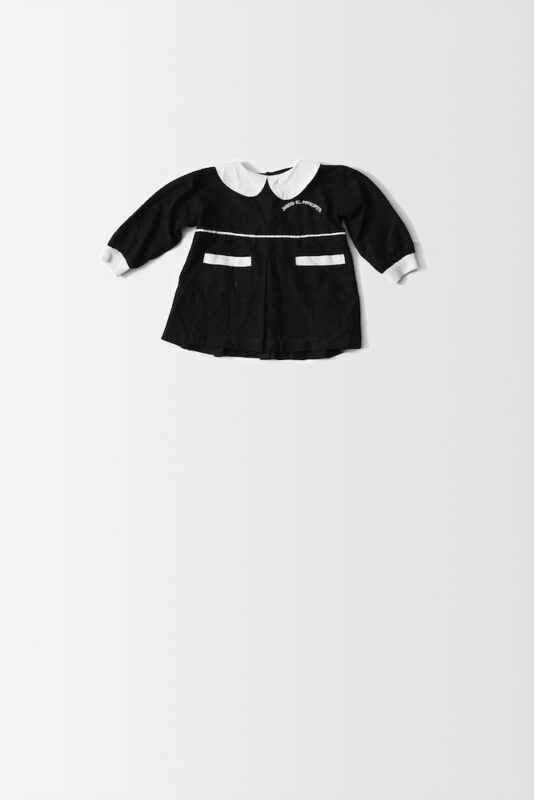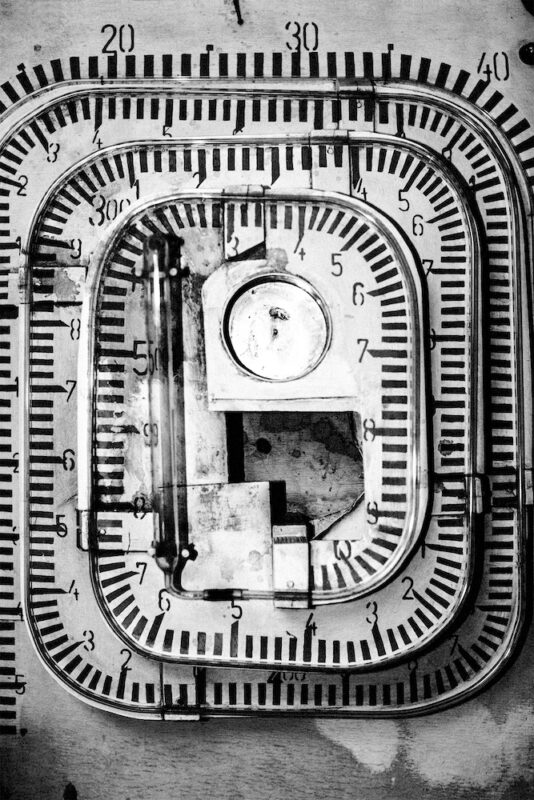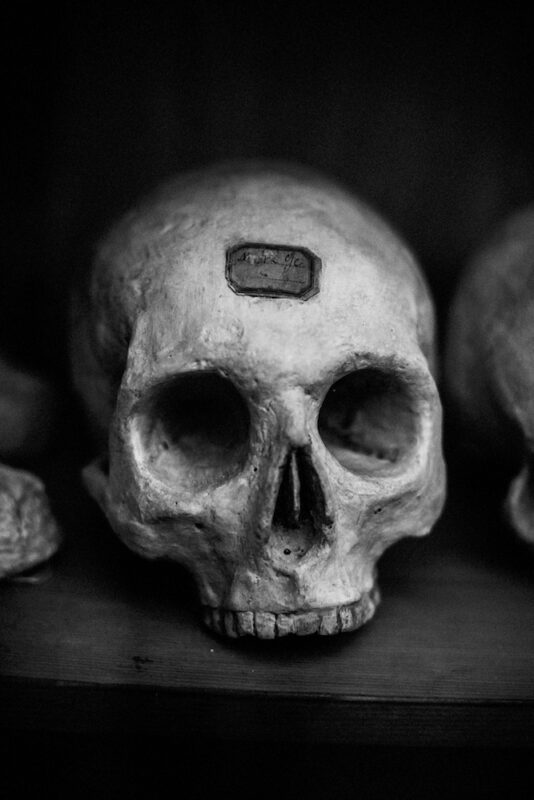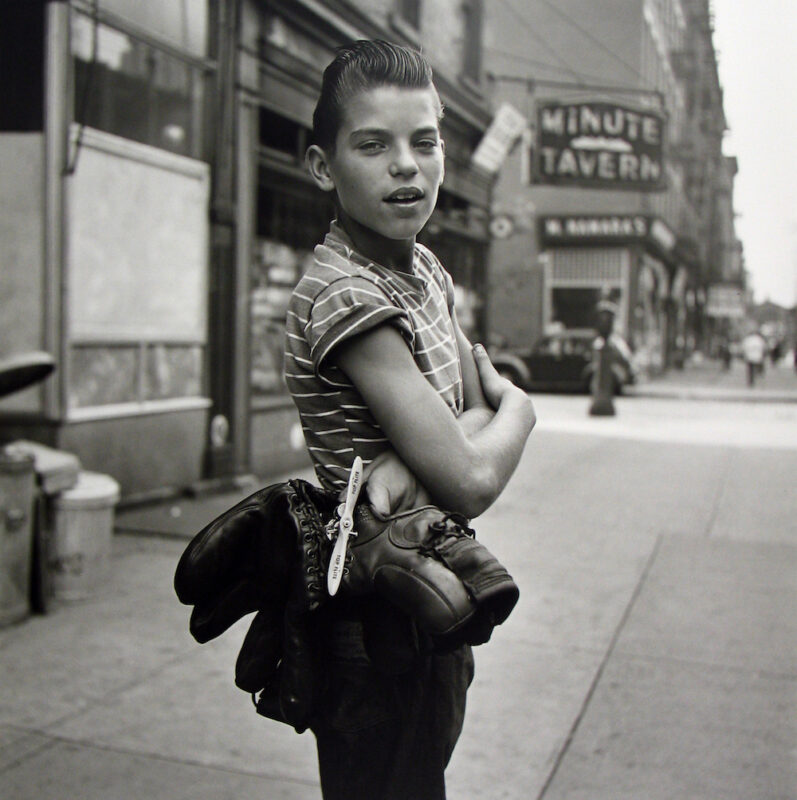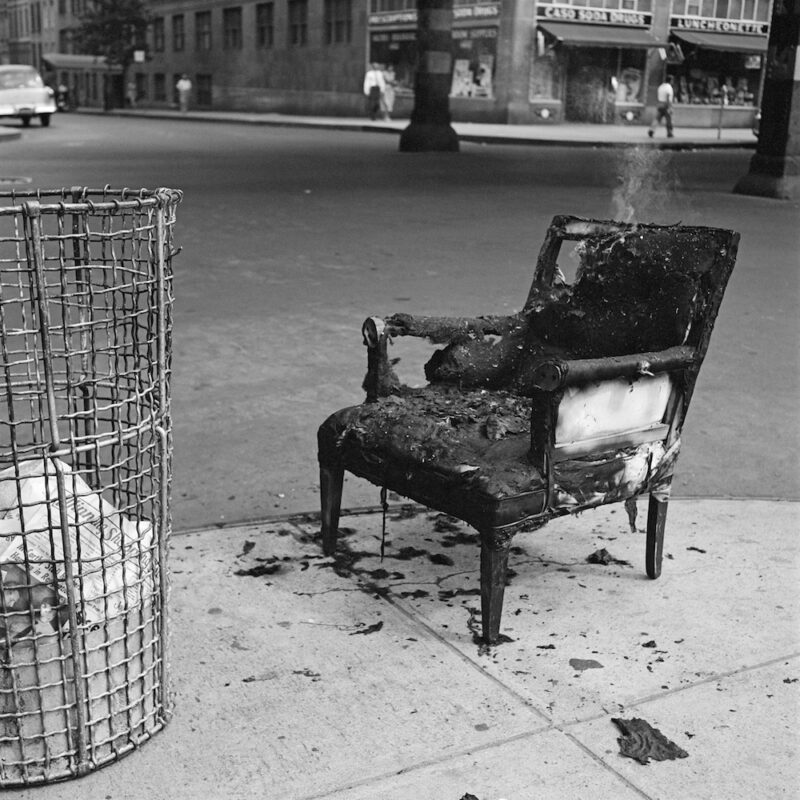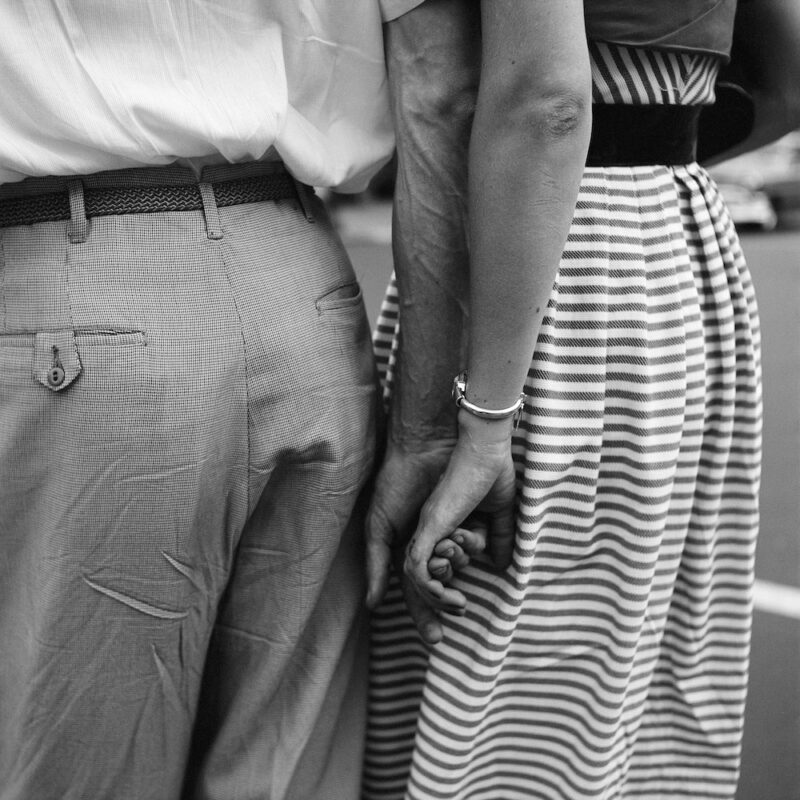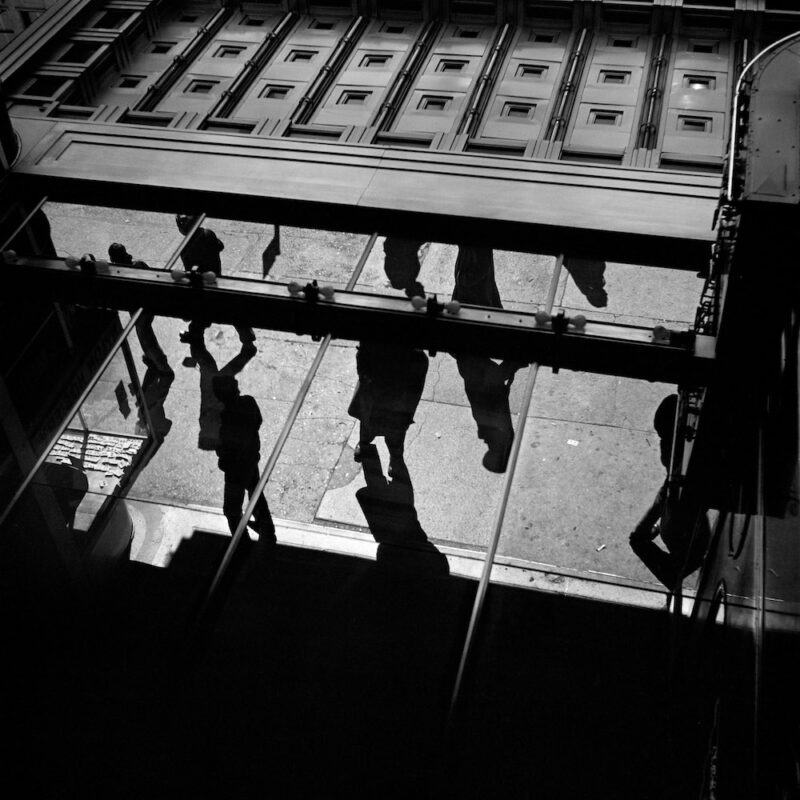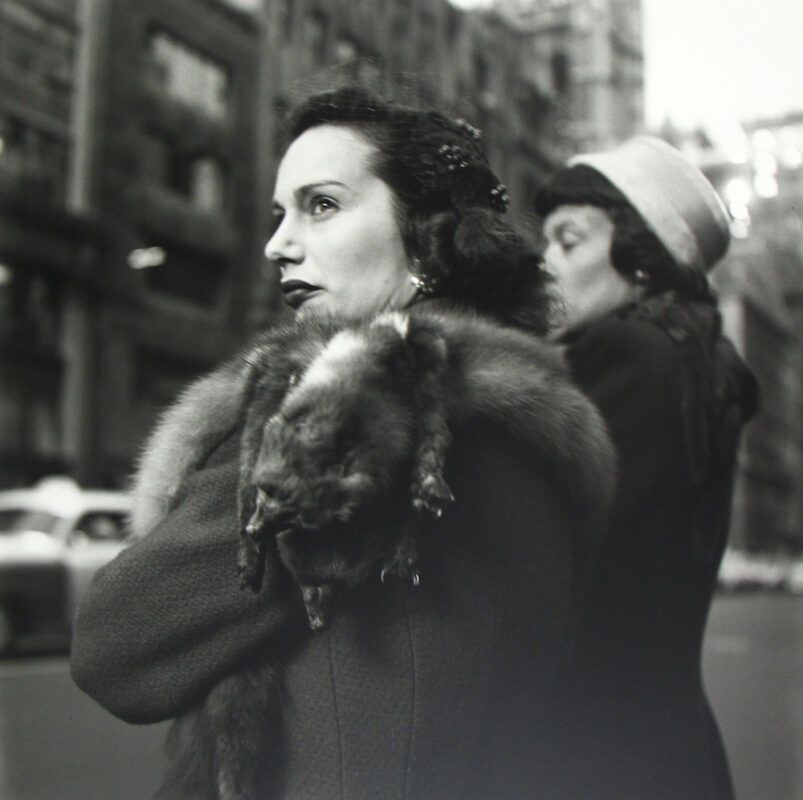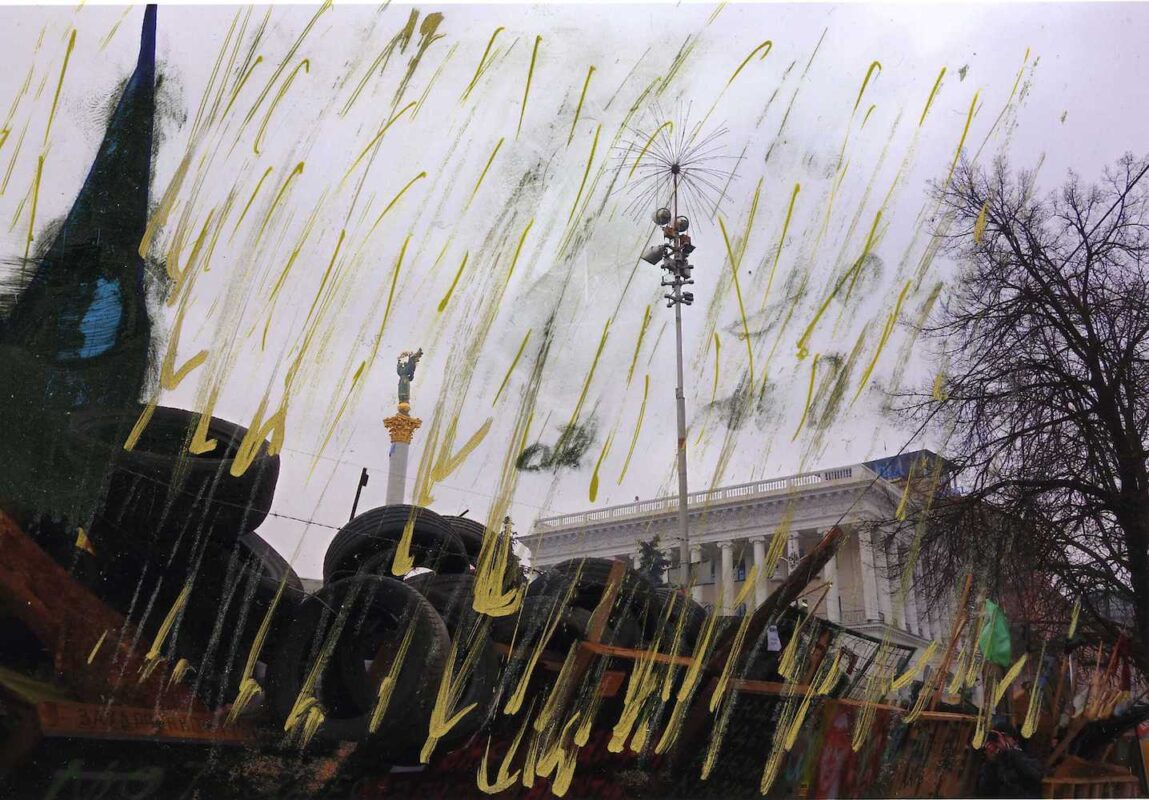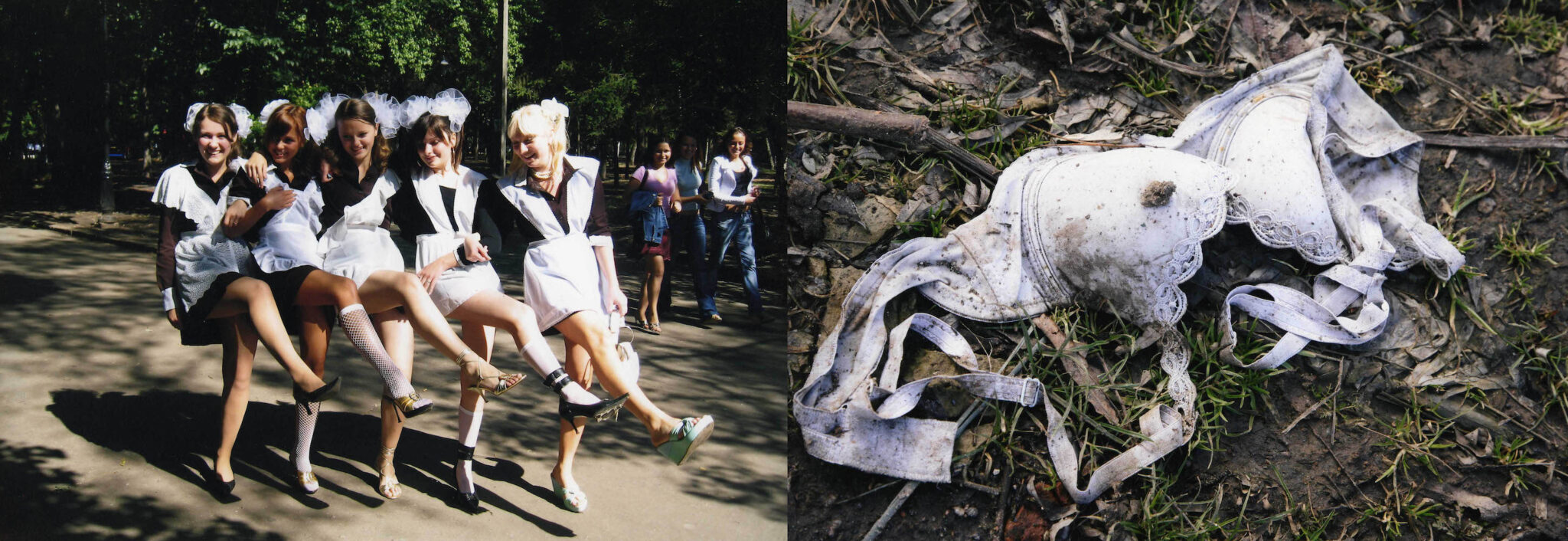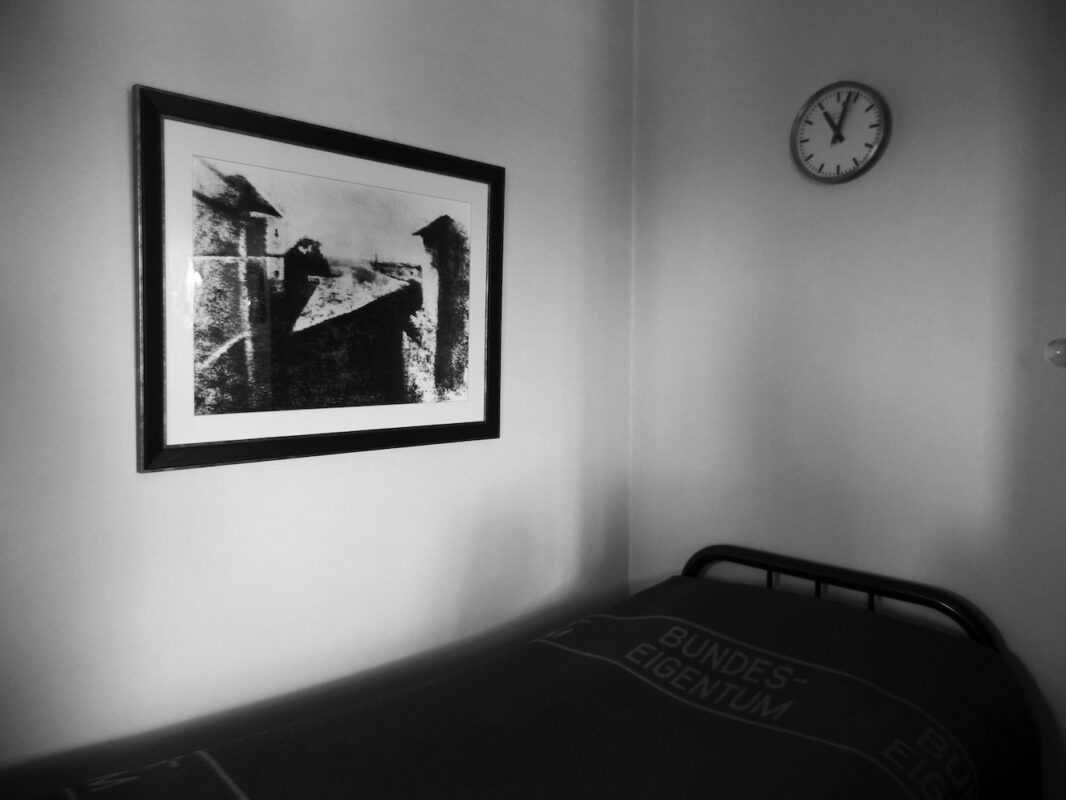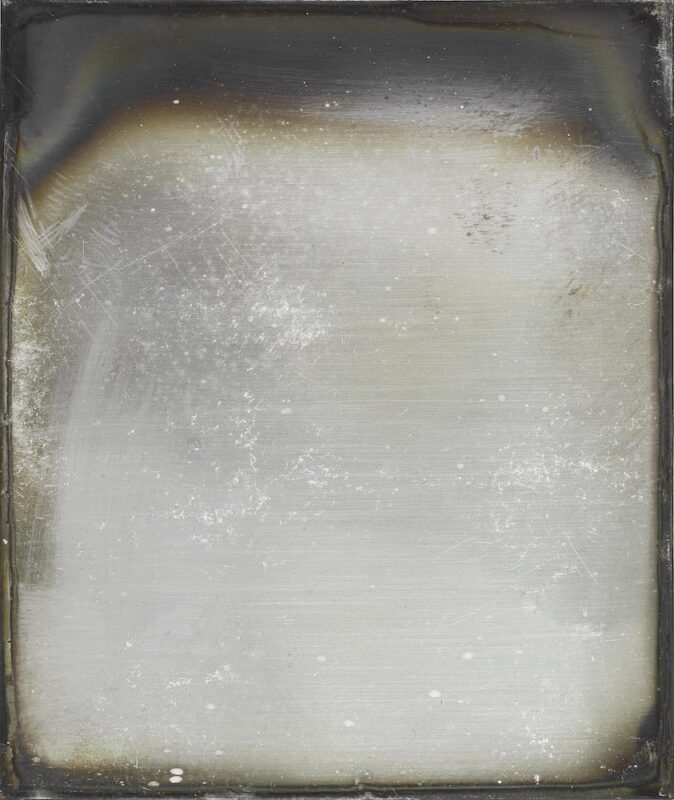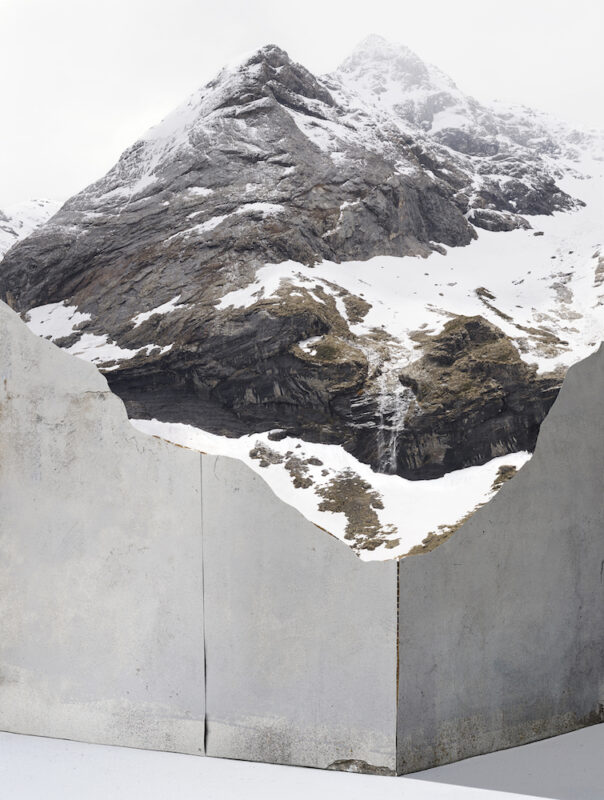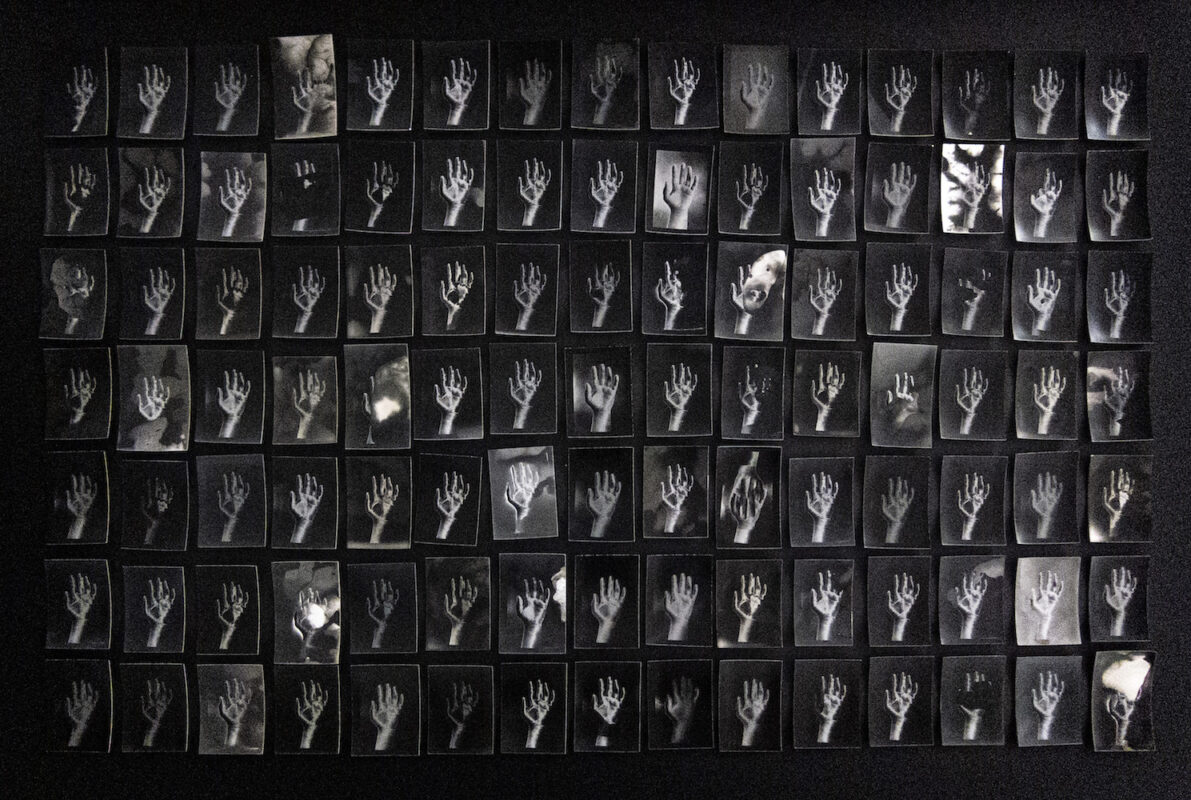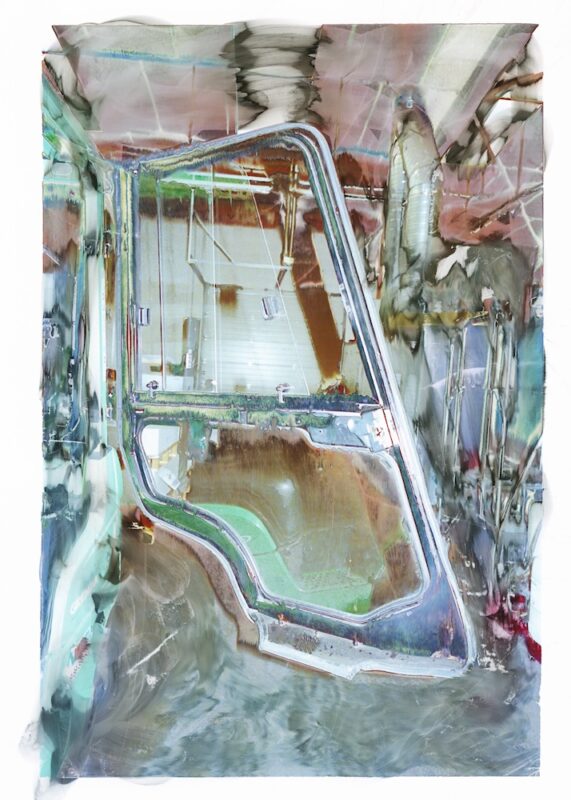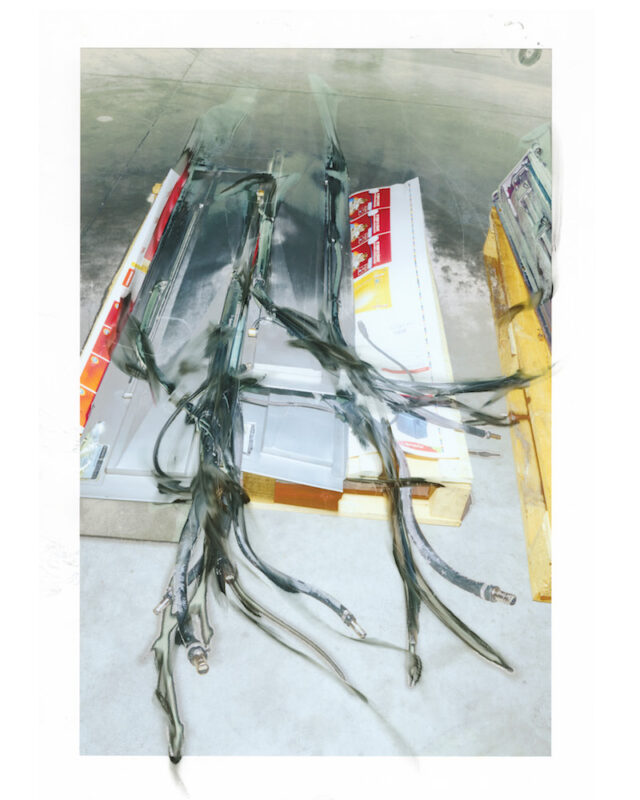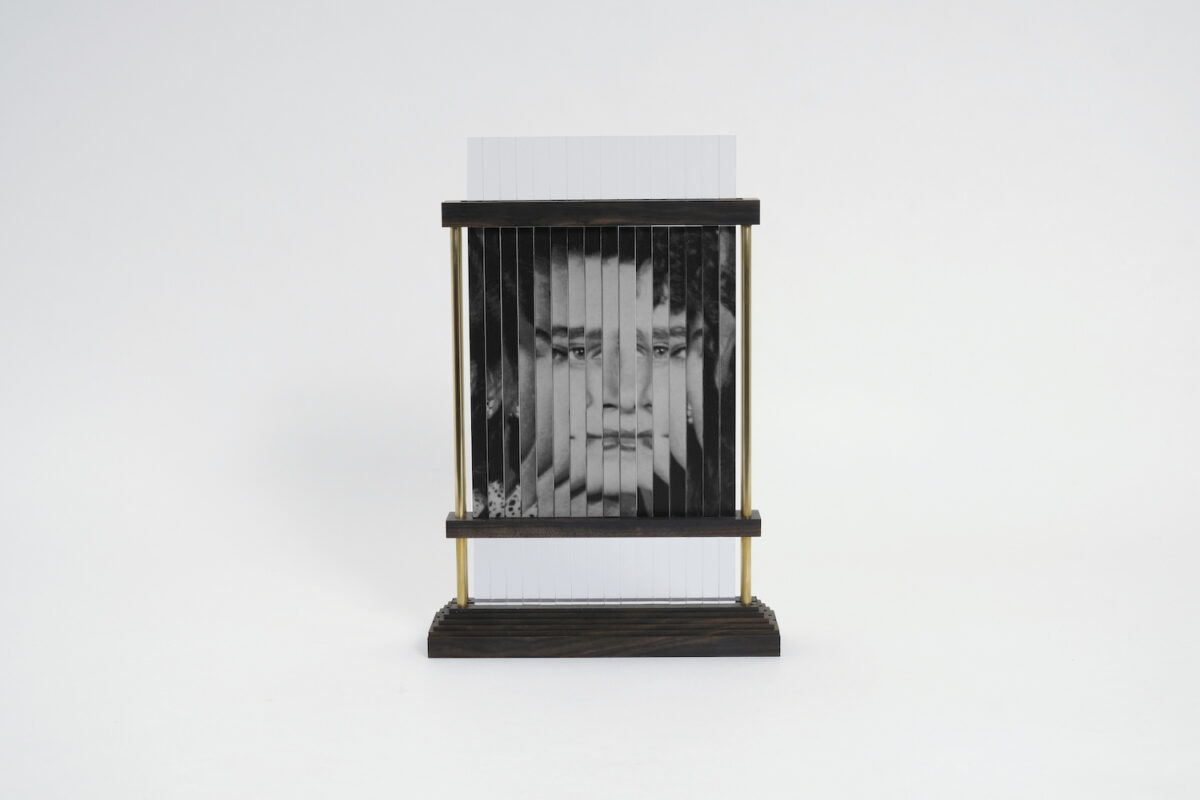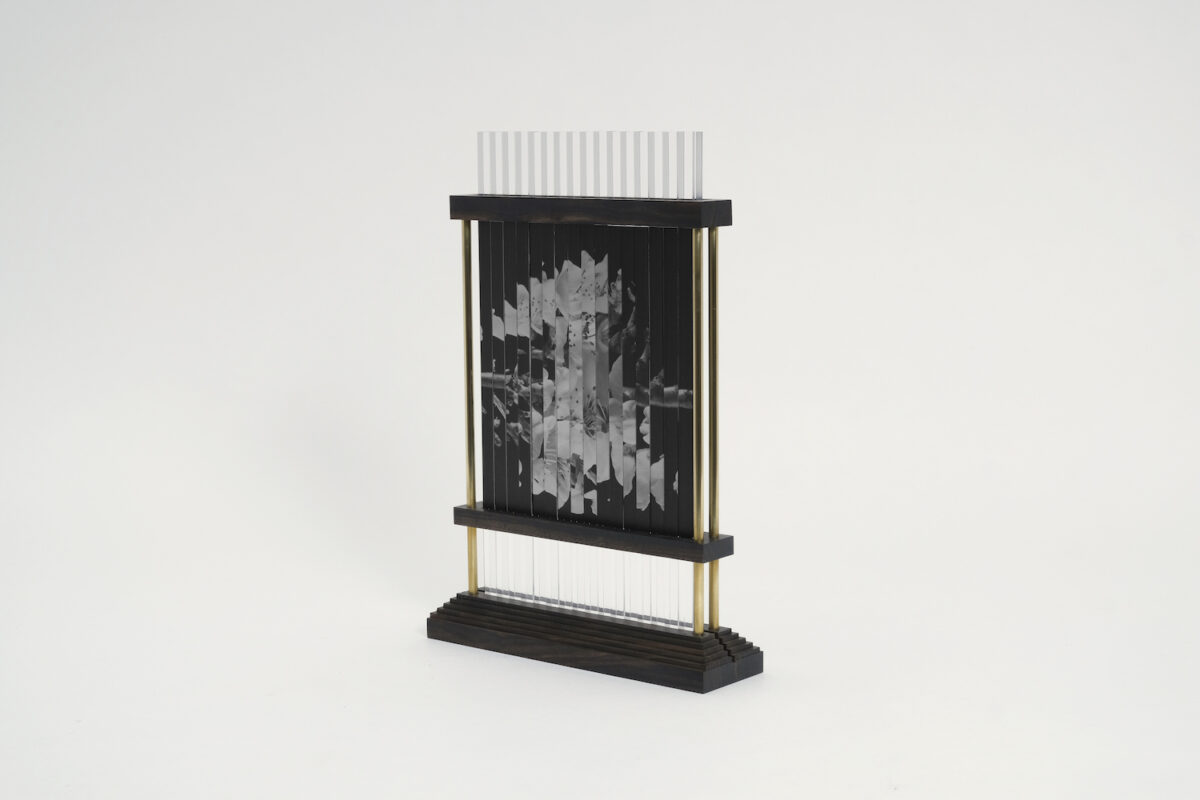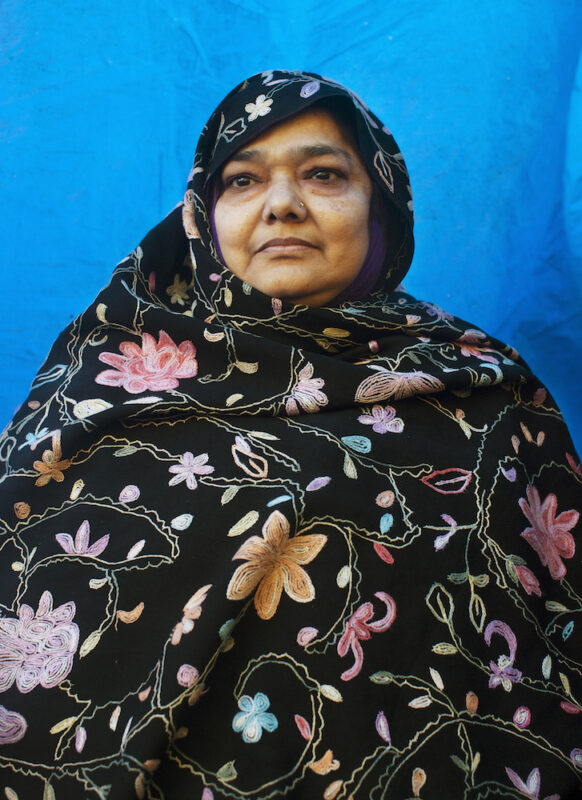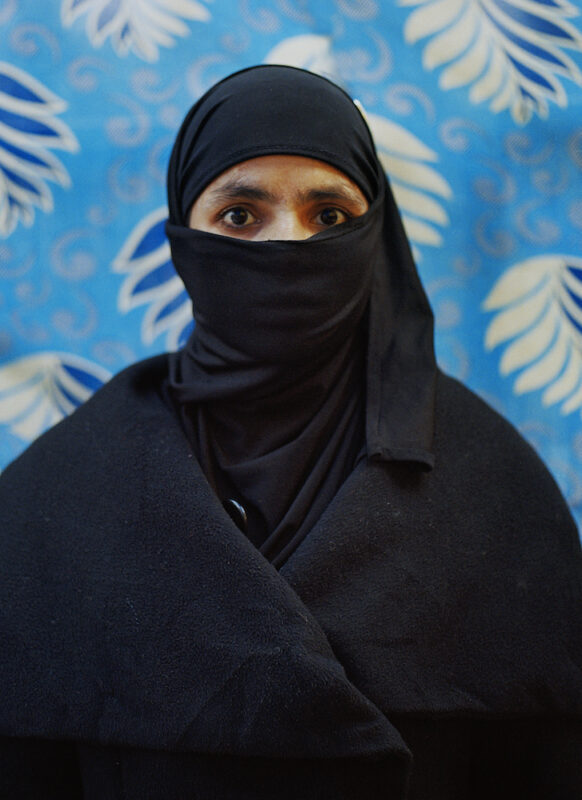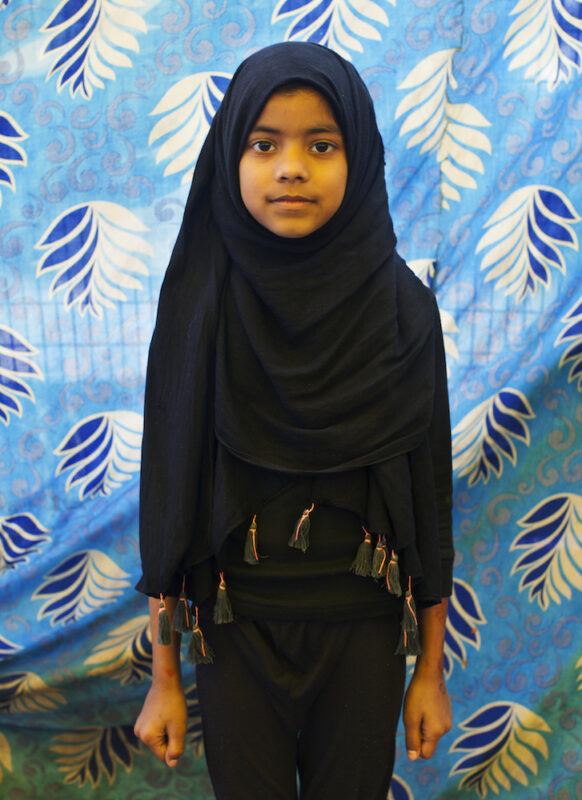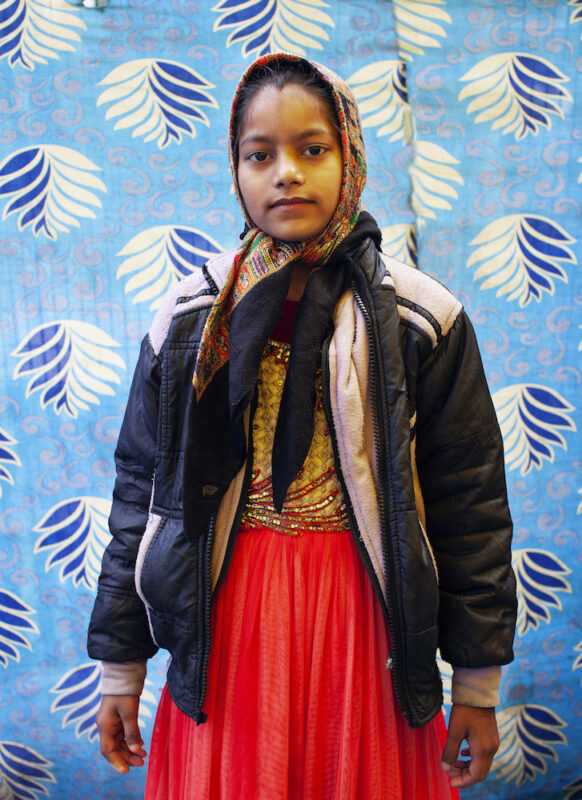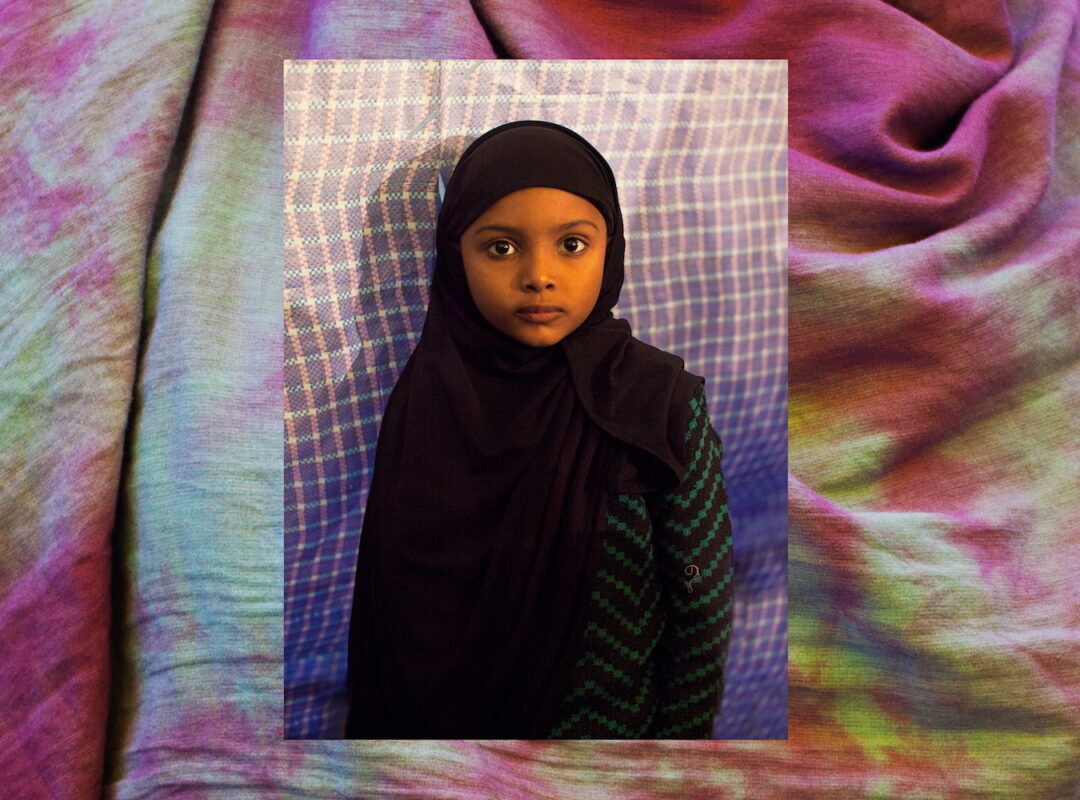Lisa Sorgini
Behind Glass
Essay by Catlin Langford
Currently on display at Centre for Contemporary Photography (CCP) in Melbourne/Naarm, Lisa Sorgini’s Behind Glass is a pandemic project comprising family portraits marked by art historical readings and an attempt to provoke discussion on the lack of awareness surrounding the relationships between children and mothers, as well as a wider misunderstanding concerning the messy realities of mothering and care, argues Catlin Langford.
A woman is seated, knees jutting forward. Her flesh compresses on the seat, a small, hollow dimple appearing on her left leg. Her face is obscured; hidden behind the naked baby she holds upwards, the child’s small foot skimming her upper thigh, and a hazy image of a cloudy blue sky and distant palm trees which falls across the woman’s face.
This layered imagery signals the driving concept informing Lisa Sorgini’s Behind Glass, a project comprising over 20 portraits of family groupings. Each work in the series was photographed through windows, or rather “behind glass”. The images reflected in the window glass become further characters in the portraits. It is multi-functional, serving as both a distinct aesthetic device, producing layered, painterly images, but also drawing attention to the unique circumstances under which the series was produced.
Behind Glass was conceived during the pandemic. Whilst social structures were significantly altered in this period of upheaval, mothers still found themselves undertaking most of the caring duties and were shouldered with even further responsibilities when other systems, like schooling, were not in place. Sorgini, at home with her two children and unable to work, responded to this personally and sought to document and reflect on the strange culture of parenting and care during the pandemic.
Created during the pandemic, Behind Glass was also held back by the pandemic. Its current showing at the Centre for Contemporary Photography (CCP) in Melbourne/Naarm is the first exhibition of the series in Australia. The images speak to both the collective and individual experience of the pandemic and undoubtedly resonate with the Melbourne population who were witness to a widely publicised ‘world’s longest lockdown’.[1] Sorgini is based in Bundjalung Country, in northern New South Wales. Like most of Australia, at some point this area was under stay-at-home orders, movement restricted to a five-kilometre radius. Complying with these rules, Sorgini sourced subjects within this perimeter via friends, neighbours or connections through contacts and social media. At their homes, she would direct her subjects via telephone or speaking through the glass, her six-month-old son sometimes strapped to her body as she photographed.
There is a naturalness to the photographs that one would not assume based on the circumstances of their creation and reveals Sorgini inherent understanding of her subjects. But there is also a theatricality, the works recalling art historical compositions. The scenes depicted are adorned in a golden light, a warmth permeating throughout the series. The light lifts the subjects, giving the everyday scenes a sense of grandeur. The presence of the windows serves as a framing device, recalling the presentation of artworks in galleries. It also evokes the Trompe-l’œil trickery of Northern Renaissance paintings, the frame painted into the image, questioning the audience’s conception of image versus reality. In Sorgini’s work, we are audience to two realities: the private interior world of the subject, shown through the window, and the exterior realities reflected in the glass. We capture glimpses, objects and scenes of interior domesticity, which contrast the outside expanse of forests, gardens or open blue skies. Whilst this outside world was off-limits to many during the pandemic, for mothers, leaving home can be difficult under the weight of responsibilities and the, at times, isolating and trapping experience of new motherhood.
The present exhibition of Behind Glass at CCP draws attention to possible art historical readings. Photographs are grouped to encourage viewers to read and reflect on artistic depictions of the baby Jesus, the Three Graces and memento mori still lives. A secondary grouping depicts women nursing their infant children. Learned cultural understandings encourages a comparison to the Madonna and Child. But the mothers’ faces are obscured, hidden whilst in the midst of enacting caring duties.
This is a subtle signal to Sorgini’s wider concerns for the series and the themes embedded in her artistic practice. Sorigini is interested in the often-unacknowledged and unseen care given by mothers; a care that is widely accepted and expected, if unrecognised and unappreciated. In her exploration of care, Sorgini also considers the transferral and evolution of care and how it manifests in a variety of situations. In one work, a middle-aged woman looks out the window. Beside her, an elderly woman is seated, her unfocused gaze directed towards the viewer. The relationship between mother and daughter has altered, shifted and now swapped.
In curating the show, we discussed Sorgini’s recent travels to Italy and her experiences there of viewing works, including Renaissance paintings, in churches and galleries. We wanted to capture some sense of this experience, and the works have been purposefully shifted to above centre-line so the viewer must gaze upwards. This imbues the subjects with a greater sense of importance, as the role of care should be given, and further underlines their comparison to masterpiece artworks.
Such reverence is particularly notable given the unflinching honesty of the images. While expressing deep love and tenderness towards their family, the mothers appear tired in their role as central caregiver and provider. Interactions largely seem to be based on touch and need – grabbing, suckling, holding, supporting – an amalgamation of limbs and flesh. Flesh is a central motif, and Sorgini recognises and records the distinct changes which occur to the body during and following birth, and the caring duties which follow. The body wears the scars of such change, from stretch marks to ageing skin.
At a panel with fellow exhibiting artists Ying Ang and Odette England, Sorgini spoke of the misunderstandings surrounding her work and the tendency for the images to be viewed sexually, related to the depiction of flesh and touch. A discussion ensued on the lack of awareness surrounding the relationships between children and mothers, as well as a wider misunderstanding concerning the messy realities of mothering and care.
Home Truths: Photography and Motherhood curated by Susan Bright was first exhibited in 2013 at the Foundling Museum, in collaboration with The Photographers’ Gallery, London. The exhibition sought to challenge stereotypes and sentimental views of motherhood, pursuing a depiction which was candid and revealing. In the decade since, honest revelations around motherhood remain relatively rare, and can ignite endless criticisms, their voices heightened in the age of social media. There is still much work to be done in centring, envisioning and reflecting the stories and experiences of motherhood, mothering and care, as is central to Sorgini’s practice. ♦
All images courtesy the artist and the Centre for Contemporary Photography © Lisa Sorgini
Installation views of Behind Glass at the Centre for Contemporary Photography (CCP), Melbourne/Naarm until 9 April 2023. Photographs by Hannah Nikkelson. In a collaboration between the CCP and the V&A’s Women in Photography project, there will be a panel discussion with Ying Ang, Odette England and Lisa Sorgini, chaired by Susan Bright, on 5 April.
—
Catlin Langford is curator at the Centre for Contemporary Photography, Melbourne/Naarm. She has previously held positions at the V&A, Royal College of Art and Royal Collection Trust. She will be undertaking a fellowship at Cité internationale des arts, Paris in spring 2023 to continue her research on autochromes.
Images:
1-Hannah and Ochre in the dining room, Clunes © Lisa Sorgini
2-Leah and Ethan in the bedroom #2, Pottsville © Lisa Sorgini
3-Jules and Alby in the dining room, St Helena © Lisa Sorgini
4-Amelia and Una in the dining room © Lisa Sorgini
5-Sarah and Ellaine in the living room, South Golden Beach © Lisa Sorgini
6-Beck with Matilda and Indigo at the front door #2, Mullumbimby © Lisa Sorgini
7-Hannah and Ochre in the dining room, Clunes © Lisa Sorgini
8-Abigail and Marigold in the kitchen #2, Federal © Lisa Sorgini
9-Installation ‘Behind Glass’ at Centre for Contemporary Photography © CCP/Hannah Nikkelson
10-Installation ‘Behind Glass’ at Centre for Contemporary Photography © CCP/Hannah Nikkelson
References:
[1] Calla Wahlquist, “How Melbourne’s ‘short, sharp’ Covid lockdowns became the longest in the world”, The Guardian, 2 October 2021.

